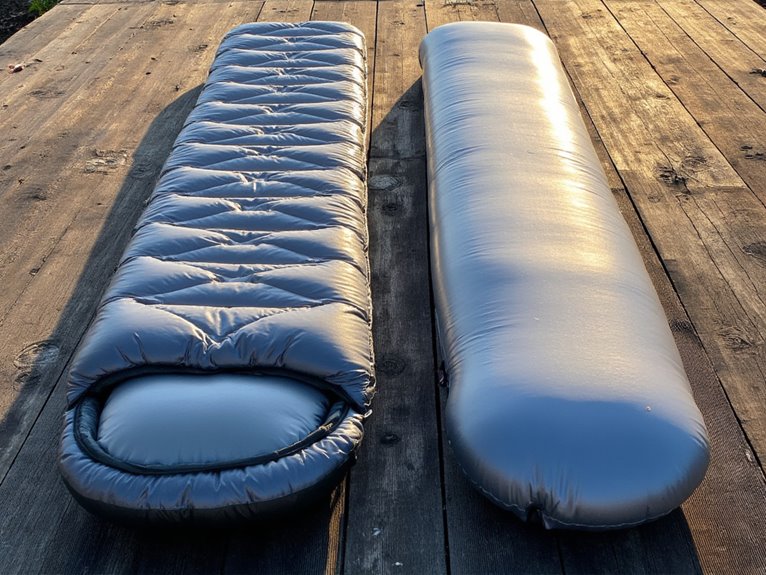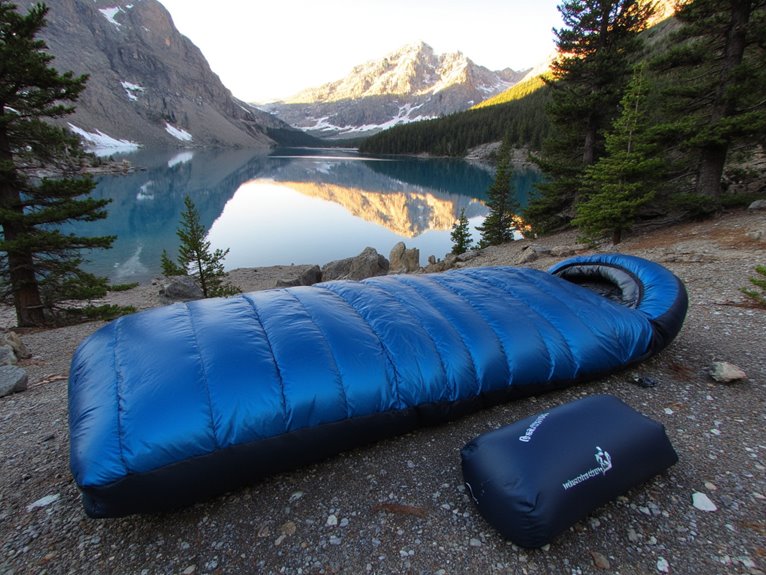Self-Inflating Vs Air Pads
Self-inflating pads use open-cell polyurethane foam cores that automatically draw air when you open the valve, offering superior durability and insulation but weighing over 2 pounds. Air pads require manual inflation but compress to water bottle size and weigh as little as 12 ounces, making them ideal for ultralight backpacking. Self-inflating models cost $50-$200 and excel in car camping, while air pads range $70-$300 and suit multi-day treks where weight matters most. Understanding these trade-offs will guide your selection.
We are supported by our audience. When you purchase through links on our site, we may earn an affiliate commission, at no extra cost for you. Learn more. Last update on 10th December 2025 / Images from Amazon Product Advertising API.
Notable Insights
- Self-inflating pads use foam cores for better puncture resistance, while air pads rely on lightweight TPU films making them more vulnerable to damage.
- Air pads weigh as little as 12 ounces and compress smaller, whereas self-inflating pads typically weigh over 2 pounds due to foam cores.
- Self-inflating pads automatically inflate in five minutes when valves open, while air pads require manual pumping or built-in foot pumps.
- Self-inflating pads provide superior insulation and body conformity through foam cores, while air pads may cause users to feel ground more acutely.
- Self-inflating pads suit car camping and cold weather expeditions, while air pads excel for ultralight backpacking and space-constrained scenarios.
Design and Construction Differences
When you’re comparing sleeping pad construction, the most fundamental difference lies in the core materials each design employs.
Self-inflating pads sandwich open-cell polyurethane foam between sealed fabric layers, typically nylon or polyester. This foam core expands when you open the valve, drawing air inside automatically.
Self-inflating pads use expanding polyurethane foam cores that automatically draw air through opened valves for effortless setup.
Air pads eliminate foam entirely, using airtight TPU films to create sealed chambers.
The construction materials directly impact structural integrity. Self-inflating designs distribute pressure through their foam core, making them more resistant to punctures and providing consistent support. The open-cell foam is created through a reaction between diisocyanates and polyols, resulting in a lightweight yet durable structure.
Air pads rely solely on multiple internal bladders shaped in specific patterns for stability. These chambers are heat-sealed and quilted for comfort, but they’re more vulnerable to damage without internal foam support backing them up. Air pads offer adjustability in firmness by allowing users to control the amount of air inside the chambers.
Inflation and Deflation Mechanisms
The way you inflate and deflate your sleeping pad depends entirely on its internal construction and valve design.
Self-inflating pads use open-cell foam that automatically draws in air when you open the valve, while air pads require you to manually blow or pump air through their valve systems. Self-inflating pads typically take about five minutes to inflate and may require a few additional breaths to achieve optimal firmness.
Some models feature built-in foot pumps that can inflate a pad in just 30-60 seconds, significantly reducing setup time compared to traditional manual inflation methods.
Understanding these different mechanisms will help you choose the right pad for your camping style and determine how much effort you’ll need to set up camp each night. Self-inflating models offer convenient setup for campers who want to minimize time spent preparing their sleep system.
Self-Inflating Foam Mechanisms
Breaking down self-inflating pad mechanics reveals an elegant engineering solution that combines foam’s insulation properties with air’s cushioning benefits. The open-cell polyurethane foam features interconnected cells that allow air flow while maintaining structural integrity. When you open the valve, compressed foam naturally expands and draws air inward through the fabric shell.
| Component | Function | Performance Factor |
|---|---|---|
| Open-cell foam | Provides insulation and structure | Foam characteristics determine expansion rate |
| Airtight valve | Controls air flow in/out | Direct impact on inflation efficiency |
| Fabric shell | Seals system while allowing expansion | Prevents air leakage during use |
This passive inflation typically achieves 70-80% full thickness automatically. You’ll need minimal manual topping off for ideal firmness, making setup remarkably efficient compared to traditional air-only pads. After the initial self-inflation process, you can add more air using a pump sack or manual pump for optimal comfort. The entire self-inflation process generally takes a few minutes to half an hour depending on the mat’s thickness and foam density.
Air Pad Valve Systems
Unlike self-inflating pads that rely on foam expansion, air pads depend entirely on their valve systems to control inflation and deflation processes.
You’ll encounter several valve variations, including twist valves that open or close based on rotation direction, push-pull valves operated by plunger mechanisms, and one-way valves that prevent unintentional air loss. Multi-function valves combine all controls in a single unit for streamlined operation.
The valve’s sealing materials directly impact performance and longevity.
Manufacturers typically use silicone or rubber sealing components to make certain airtight closure under repeated use, while valve housings utilize durable ABS plastics or reinforced polymers. Professional-grade valves often incorporate acetal plastic construction for enhanced strength and corrosion resistance in demanding conditions. Most air pads feature a valve cap positioned at the bottom side that secures the inflation mechanism and prevents accidental air release during use.
Rapid inflation valves feature larger openings for faster airflow, while deflation valves often provide dual settings for quick exhaust or gradual pressure release.
Weight and Packability Comparison
When you’re choosing between self-inflating and air pads, weight and packability become critical factors that directly impact your backpacking experience.
Self-inflating pads carry the burden of their internal foam core, making them bulkier and heavier than their air-filled counterparts.
Air pads excel in portability, compressing down to remarkably small sizes while weighing as little as 12 ounces compared to the typical 1-3 pound weight of self-inflating models. The tested models showed a weight range from 354 g to 814 g across different designs. Air pads typically have the smallest packed size, while self-inflating and foam pads are bulkier. Most ultralight air pads compress to the size of a water bottle, making them ideal for long-distance hikers prioritizing minimal pack weight.
Self-Inflating Pad Bulk
Two critical factors determine whether self-inflating pads fit your backpacking needs: weight and packability.
Self-inflating pads present unique bulk considerations due to their open-cell foam construction. The Trail Scout weighs 1 lb 8 oz while delivering excellent insulation efficiency. Thicker models like the Ampex Gear’s 3-inch pad weigh 4.0 lbs but provide superior warmth retention.
Packed dimensions vary considerably. The Sea to Summit Camp Pad compresses to 6 x 10.5 inches when deflated. Most self-inflating pads include compression straps and carry bags for secure transport.
The foam insulation adds bulk compared to air pads but enhances durability and thermal performance. You’re trading some weight for reliability and consistent insulation that won’t fail if punctured.
Air Pad Portability
Air pads dominate the ultralight backpacking category through superior weight-to-performance ratios.
You’ll find most models weighing 10-16 ounces compared to self-inflating pads that often exceed 2 pounds. The Therm-a-Rest NeoAir XLite NXT exemplifies this advantage at just 13 ounces with a packed size of 9 x 4 inches.
Air pad advantages include:
- Compact packed size – takes minimal backpack space
- Lightweight construction – reduces overall pack weight considerably
- Efficient packing – optimizes load distribution in your pack
- Easy transport – won’t strain your back on long hikes
Air pad disadvantages center on durability concerns.
You’re trading some ruggedness for portability. The 30-denier fabric construction helps, but puncture risk remains higher than self-inflating alternatives.
Comfort and Insulation Performance
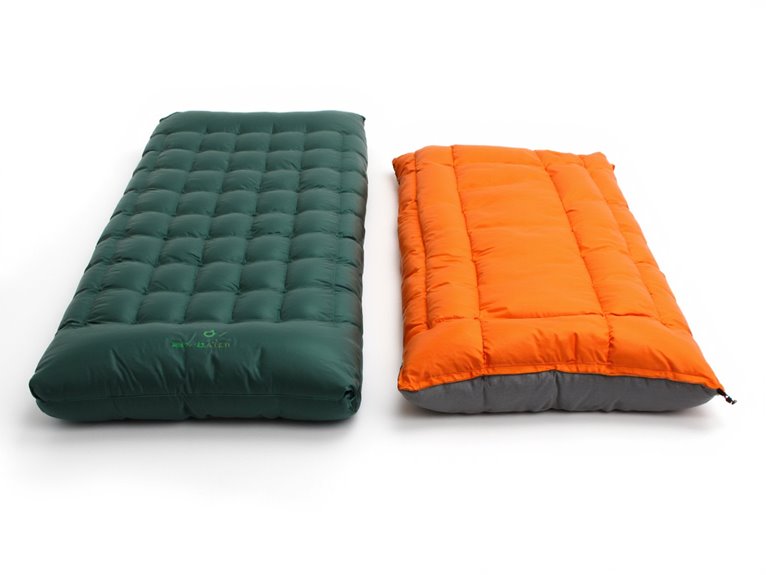
Your sleeping pad’s comfort and insulation performance directly impacts sleep quality during outdoor adventures. Self-inflating pads excel in comfort levels through adjustable firmness controls and superior cushioning depth. Their foam cores provide better body conformity compared to air pads’ thinner profiles.
Insulation efficiency varies considerably between pad types. Self-inflating pads maintain higher R-values and deliver consistent warmth transfer reduction. Air pads can suffer from dynamic insulation issues when they wobble during use.
For side sleepers specifically, proper spinal alignment requires at least 3 to 5 inches of thickness to adequately support hips and shoulders while preventing painful pressure points.
| Feature | Self-Inflating Pads | Air Pads |
|---|---|---|
| Thickness | Generally thicker, plush design | Typically thinner profile |
| R-Value Range | Higher across seasons | Variable, often lower |
| Firmness Control | Adjustable through air pressure | Limited customization options |
| Cold Weather | Superior performance | Adequate with proper R-rating |
Self-inflating pads prioritize comfort over weight reduction, while air pads emphasize portability.
Durability and Maintenance Requirements
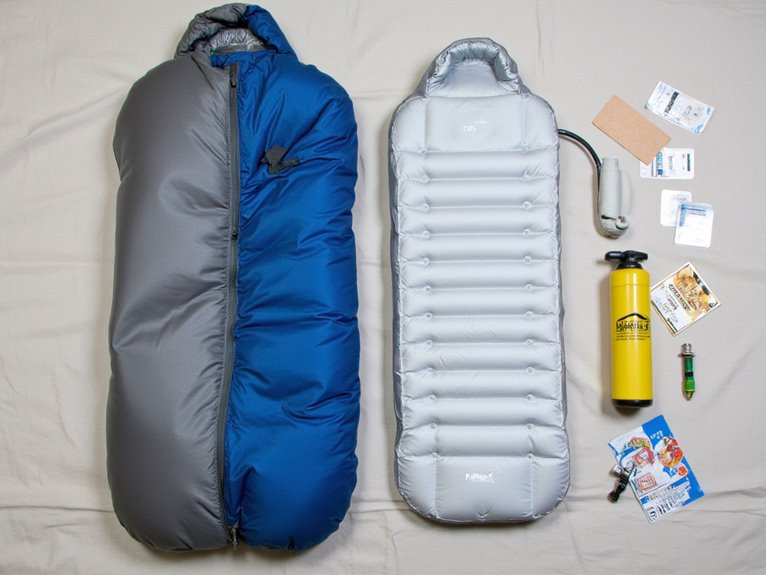
Construction quality separates these pad types in fundamental ways that affect long-term reliability.
Self-inflating pads use heavier materials with foam cores that resist punctures and impacts. Air pads rely on lighter fabrics that’re more vulnerable to damage but offer weight savings.
Your durability comparison reveals clear differences.
Self-inflating pads last longer due to fewer failure points and simpler valve systems. Air pads require more frequent maintenance and repairs, especially around valves and seams.
Essential maintenance tips include:
- Regular leak checks for air pads using soapy water
- Proper storage – roll self-inflating pads, store air pads flat
- Cleaning protocols to prevent material degradation
- Repair kit preparation for field puncture fixes
Self-inflating pads need conditioning to maintain foam effectiveness, while air pads demand vigilant valve care.
Premium air pads constructed from 40D nylon materials with TPU coatings offer enhanced tear resistance and puncture-proof performance for extended backpacking trips.
Cost Analysis and Value Proposition
Beyond maintenance considerations, price points create significant budget implications that determine which pad type delivers better long-term value for your camping style.
| Feature | Self-Inflating Pads | Air Pads |
|---|---|---|
| Price Range | $50-$200 | $70-$300 |
| Budget Options | Under $100 available | Limited under $150 |
| Premium Models | $150-$200 max | $200-$300+ |
Self inflating advantages include superior cost-effectiveness for car camping scenarios. You’ll find budget-friendly options under $100 that deliver consistent performance. Their foam core construction provides reliable comfort without premium pricing.
Air pad benefits emerge in specialized applications despite higher costs. Premium insulated models justify $200+ prices through superior warmth-to-weight ratios. You’re investing in advanced materials and engineering.
Self-inflating pads offer better value for rugged use. Many budget sleeping pads feature built-in pumps that eliminate the need for external inflation equipment, adding value to lower-priced models. Air pads excel when weight savings justify increased expense.
Best Use Cases for Each Pad Type
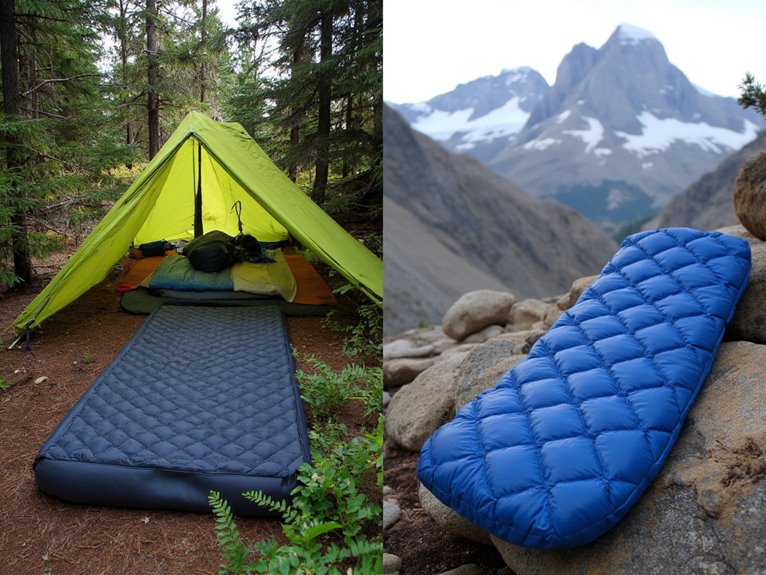
Three distinct camping scenarios determine which pad type delivers ideal performance for your specific needs. Your pad selection criteria should align with weight priorities, weather conditions, and terrain challenges.
Self-inflating pads excel in car camping situations where comfort outweighs portability concerns. They’re your best choice for cold weather expeditions due to superior insulation properties from foam-air combinations.
Self-inflating pads deliver unmatched comfort and cold-weather insulation when weight isn’t your primary concern.
Rocky terrain becomes manageable with their enhanced puncture resistance and cushioning capabilities.
Air pads dominate ultralight backpacking where every ounce matters. These camping scenarios benefit from their compact packability and minimal weight penalties:
- Multi-day trek weight reduction priorities
- Warm weather trips requiring basic cushioning
- Minimalist camping with supplemental insulation layers
- Space-constrained pack configurations
Choose self-inflating for durability and warmth. Select air pads for weight savings and portability.
Making the Right Choice for Your Adventures
Why settle for the wrong sleeping pad when five key factors determine your best choice? Your decision hinges on comfort requirements, weight constraints, durability needs, budget limits, and specific usage scenarios.
Choose self-inflating pads for car camping and extended trips where comfort outweighs weight concerns. They’re ideal when you prioritize sleep quality and have space for bulkier gear.
Their foam-air combination delivers superior insulation and customizable firmness.
Select air-filled pads for ultralight backpacking and weight-critical adventures. They excel when every ounce matters and packability is essential.
Manual inflation takes five minutes but rewards you with minimal pack weight.
Consider your user preferences carefully. Comfort-focused campers benefit from self-inflating models, while weight-conscious hikers prefer air pads.
Factor in repair complexity, inflation methods, and long-term durability when making your final selection.
Frequently Asked Questions
Can I Use Self-Inflating Pads at High Altitude or Extreme Temperatures?
You can definitely use self-inflating pads at high altitude and extreme temperatures.
Their altitude performance remains stable because foam cores maintain structural integrity despite pressure changes, unlike pure air pads that lose firmness.
Temperature resilience comes from open-cell foam’s consistent insulating properties, with R-values from 3.0-7.5 handling severe cold.
You’ll need manual topping-off at elevation since thinner air reduces self-inflation efficiency.
How Do I Properly Store My Pad During Off-Season Months?
Clean your pad thoroughly with mild detergent solution before winter storage.
Verify complete drying inside and out to prevent mold formation.
Store self-inflating pads semi-inflated with valves open in cool, dry locations like closets.
Avoid damp basements or attics where temperature fluctuations occur.
Moisture control remains critical—check storage areas periodically for humidity issues.
Don’t use stuff sacks long-term; keep pads flat or loosely rolled for ideal material longevity.
What’s the Expected Lifespan of Each Pad Type With Regular Use?
Your pad durability depends heavily on usage frequency and type.
Air pads typically last 10-20+ years with proper care, limited mainly by bladder coating failure.
Self-inflating pads generally last 5-10 years before foam compression reduces insulation effectiveness.
High usage frequency accelerates wear on both types.
Insulated air pads face additional degradation from repeated compression cycles.
Regular maintenance and protective measures greatly extend lifespan for both pad types.
Are There Specific Sleeping Bag Compatibility Issues With Either Pad Type?
Sleeping bag compatibility depends on pad insulation and surface characteristics.
Air pads create slick surfaces that cause synthetic sleeping bags to slide, requiring attachment systems or gripper fabrics. Their variable thickness affects loft distribution in down bags.
Self-inflating pads offer stable, textured surfaces with consistent foam core insulation that complements most sleeping bag designs.
You’ll need waterproof shells with air pads to prevent moisture transfer from condensation buildup.
Can I Partially Inflate Pads for Different Firmness Preferences?
You can adjust firmness on both pad types through specific inflation techniques.
Self-inflating pads offer superior firmness adjustment control—simply open the valve and monitor expansion, then add or release air as needed.
Air pads require manual inflation using pumps or breath, making precise firmness adjustment more challenging.
Self-inflating pads provide easier fine-tuning since you’re working with existing foam structure plus air pressure.
On a final note
You’ll find both pad types serve distinct purposes in your gear arsenal. Self-inflating pads excel for car camping and base camps where weight isn’t critical. Air pads dominate for backpacking trips requiring minimal pack weight and volume. Your choice depends on trip duration, transportation method, and comfort priorities. Consider your specific adventure requirements, budget constraints, and durability needs. Match the pad’s design strengths to your outdoor activities for peak performance.

